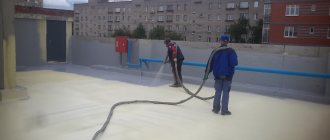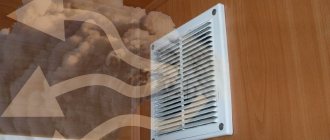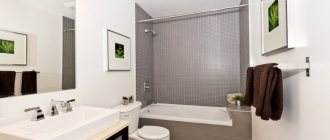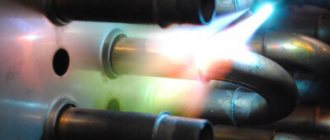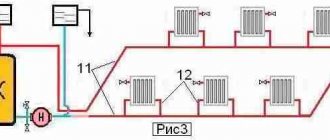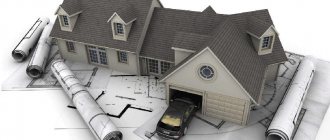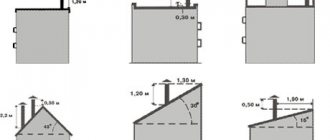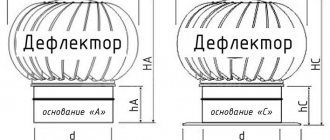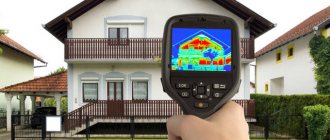When do you need a ventilation system in the pool?
Pool ventilation solves 3 problems: it supplies air for breathing, removes moisture and odors. A dehumidifier only removes moisture, and the air remains stale. But:
A dehumidifier for a pool with a mirror of 15 m2 is cheaper than ventilation. It's all about the starting price. The initial cost of any adequate ventilation system: 300,000 rubles. "Full construction". A dehumidifier for a pool of 15 m2 - the same Danvex DEH-600 will cost less - 170,000 rubles. Profitable!
Ventilation in a pool with a water mirror> 25 m2 will be cheaper and more efficient than a dehumidifier. If the water mirror is less than 25 m2, install a dehumidifier.
Installation
Installation of ventilation in the pool is carried out in stages according to the developed project documentation.
- Delivery of equipment and components to the facility is carried out according to the schedule.
- The body air duct systems are assembled and installed in the places provided for by the project.
- Thermal insulation is being carried out.
- Exhaust and supply power units are mounted.
- Auxiliary structural elements are installed (flow heaters, dryers, filter systems, etc.)
- Commissioning activities are being carried out.
- The system is brought up to the design capacity, the shortcomings are eliminated, the automation is tested in various operating modes of the equipment.
This is where the work on organizing air exchange ends.... If certain parameters are observed, the installation is handed over to the customer for operation.
The air conditioning unit consists of several units, each of which performs the necessary function:
- the recuperation system increases the supply air temperature to comfortable parameters;
- the dehumidifier maintains the humidity within the specified limits;
- the heater increases the supply air temperature to comfortable values;
- filter elements purify the flow entering the inside;
- the power plant organizes the air flow in a specific direction at a calculated speed;
- air valves are system controls;
- automation ensures efficient and economical operation of the equipment.
How to remove moisture by ventilation? Principle of operation
In summer, when the air outside is humid, we simply blow through the pool area with an increased volume of air. For these purposes, we use separate supply and exhaust units.
In winter, when the air outside is cold and dry, we simply heat it up in the supply unit and supply it to the pool. The supply jets are directed to the water mirror to maximize moisture absorption. We hang the supply and exhaust units under the ceiling of the garage or in any other technical room. Under the ceiling of the pool, we spread a network of air ducts through which we remove the moist air to the street.
In winter, draining the pool requires 7 times less air than in summer. The air handling unit operates at a minimum in winter, so no recuperators are needed.
Thus, ventilation units for swimming pools operate in 2 modes - Summer and Winter.
Summer: The air outside is warm and humid, therefore it is supplied to the pool room without heating. The moisture content in summer is very high - 12.8 g / kg. Therefore, in order to remove moisture from the pool with the already humid outdoor air, you have to blow the pool room with a large volume of air, i.e. take not quality, but quantity.
Winter: The situation is reversed. The air outside is cold and needs to be heated to supply it to the pool. But the main thing is that it is very dry. Its moisture content is only 0.39 g / kg, i.e. winter air 32 times drier than in summer, which means that the volume of such air is needed much less.
for example, for dehumidification of the air in a pool with a water surface of 25 m2, in the summer you need about 3000 m3 / h of air, and in the winter - only 400 m3 / h, which is 7.5 times smaller.
How much does a turnkey pool ventilation cost?
The company is given different prices. In the table below, I have given the best prices for the market. I am a designer and make money from designing. I post the prices not for the purpose of putting pressure on the installation companies, but for the purpose that my Customers understand the order of prices and do not faint.
Unlike the same dehumidifiers, the cost of ventilation equipment practically does not depend on the size of the pool. The main price tag is in the branching of the air duct network and the cost of installation work.
| Water mirror area | |||||
| The cost | 15 m2 | 21 m2 | 28 m2 | 35 m2 | 40 m2 |
| Equipment | 180 000 | 220 000 | 230 000 | 250 000 | 280 000 |
| Materials (edit) | 110 000 | 140 000 | 160 000 | 190 000 | 210 000 |
| Work | 70 000 | 80 000 | 80 000 | 110 000 | 140 000 |
| Total | 370 000 | 440 000 | 470 000 | 550 000 | 630 000 |
There are more than 20 brands of ventilation equipment on the market with different price policies. The table shows the most simple and effective pool ventilation system based on NED and Breezart equipment. Without a project, you cannot be sure of the correctness of decisions, and installers will not be able to assemble the system.
Project cost from 25,000 to 36,000 rubles.
CComparison with desiccants: Yes, in some cases a dehumidifier will be cheaper than ventilation For example, in pools with a water surface of 25 m2, the dehumidifier is 20% cheaper. But when installing a dehumidifier, in any case, you will have to install a simple ventilation system for banal ventilation of the room. As a result, the combined ventilation and dehumidification system will be much more expensive than full ventilation designed to remove moisture. In pools with a mirror of 35 m2 or more - the cost of a dehumidifier and ventilation is the same, but the dehumidifier's functionality is much less.
Types of ventilation systems
There are several schemes for a ventilation system for the pool. Which one exactly needs to be chosen depends on the parameters of the room (its size, how often it will be used, how many people will be at the same time, what kind of layout).
Schemes can be conditionally divided into two types:
- supply and exhaust system;
- supply and exhaust system with an air dryer.
The use of only one dehumidifier, without a planned ventilation system, will not give special results: it is necessary to ensure the supply of fresh air and the removal of exhaust air, and not only its dehumidification. You also need to understand that in 99% of cases, forced systems are used. Natural schemes are practically not used: they do not provide fast air exchange, cannot be regulated normally, and their efficiency largely depends on weather conditions. As a result, with high humidity, they will renew the air for too long.
Supply and exhaust
Both the inflow and removal of air in them are carried out through the fans. Alternatively, in small rooms (or in rooms with a small pool and a low level of humidity), only the removal system can be forced, and the inflow is carried out through valves or windows.
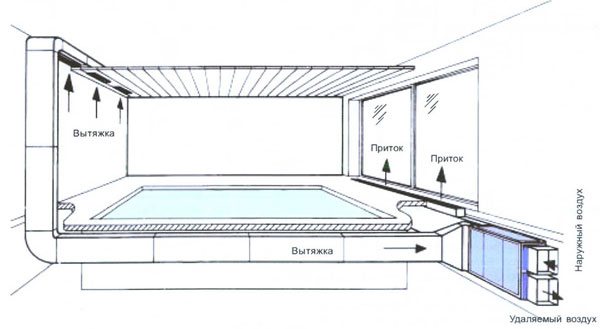
Swimming pool ventilation diagram
Such a system is distinguished by its simplicity and relatively low cost, since no additional climatic equipment (dehumidifiers) is required. It is advisable to use it for pools with an area of up to 20 m² (water mirror).
Sometimes it is enough just to open a window in the room, and only for the duration of airing (that is, after bathing).
Supply and exhaust with dehumidification
Such a system implies minimal (or, as it is also called, sanitary) air exchange. Humidity is reduced not due to air removal, but due to special equipment: dehumidifiers.
It is advisable to use such a system for rooms with a pool of up to 40 m² (water mirror).
Ventilation scheme in the pool (video)
Why can't you immediately contact the installation company?
Pool ventilation is a technological system.It is NOT calculated using standard methods of air exchange rate and thus is fundamentally different from ventilation in a cottage, office or restaurant. Therefore, the decisions that installation firms will put into your estimate in 90% of cases will be incorrect.
If you already have an estimate for the installation, you can send it to me and I will tell you all their mistakes.
At first, In most private pools, specialized installations with recuperators and a dehumidifier are not needed. They are expensive and are used for very different purposes. Secondly, Automation, which is built into most installations, requires specification at the factory. You can't buy any rig and hang it. Such equipment will not work properly. The units must be programmed according to the humidity schedule. Thirdly, Installation firms select installations at random. And this is not a slip of the tongue on my part. To make the right selection, they should ask you what additional equipment you plan to put into the pool and the mode of switching on this equipment. More often than not, no one asks anything. For example: For a pool with a counterflow, equipment for 1500m3 / h is required for 230,000 rubles, and for a pool without a counterflow - for 900m3 / h for 145,000 rubles. One question saves the Customer from 85,000 rubles.
Calculations as part of the design of the ventilation system
To select the right ventilation equipment, duct cross-section and system configuration, it is necessary to perform a number of engineering calculations. No full-fledged pool project is unthinkable without the calculated part. Here are the basic calculations that must be included in its composition.
Determination of areal characteristics
At this stage, initial data are collected on the area of the pool mirror, the volume of the room, the size of the aisles, the paths of the fences, the presence of utility rooms, the design features of the building, the number of bathers, etc. This allows you to select the standardized values of air characteristics for further calculations in accordance with current requirements.
Calculation of temperature parameters
Depending on the purpose of the pool and its area characteristics, standardized temperature parameters are selected, which must be provided by the selected ventilation equipment. In this case, it is necessary to take into account the presence of heating systems, additional heat release and heat losses.
The ideal option would be to choose pool ventilation with the inherent ability to switch to different operating modes. This should ensure compliance with seasonal changes, as well as a change in the purpose of the pool, for example, from a sports to a health-improving one. The temperature requirements for each variety are listed above.
Determination of design data to achieve the optimal level of air humidity
For the accepted temperature conditions, the amount of evaporated moisture is calculated and the capacity of the drying installation is determined.
An important parameter for this calculation is the dew point (the temperature at which condensation forms on windows, walls and supporting structures). The purpose of the pool ventilation system is to maintain conditions under which the dew point will not be reached and the relative humidity level will be within the normal range.
Determination of the amount of generated moisture
The main sources of evaporating moisture in the premises under consideration are:
- The water mirror of the pool itself
- Detour paths around him
- Supply air flow from the street
- Swimming people with a large number of them
- Water slides and attractions, if any
When the pool is not in use, water evaporation is also reduced, lowering the relative humidity level. Therefore, the air handling unit is designed to operate in two modes.
Determination of the speed of air movement in the pool
The projected ventilation unit must ensure the mobility of air masses at a level not exceeding 0.2 meters per second. Otherwise, increased airflow to the skin can lead to hypothermia and colds.
An increase in air mobility will also cause a decrease in the permissible humidity level and a decrease in the comfort of bathers.
Calculation of air exchange characteristics
Another important calculation that must be performed when developing project documentation is the calculation of the air exchange rate. This characteristic shows how many times the air is completely replaced in the room every hour. The parameter of the air exchange rate is standardized by the current regulatory documents.
As a result of the calculation, the capacity of the ventilation unit is determined, as well as the cross-section of the installed air ducts.
The following are taken as the initial data for the calculation:
- The amount of water evaporating in the pool
- Areal characteristics of the water mirror and paths around it
- Specified Moisture Release Index for Used and Unused Space
- Required inflow of external air masses
Determining the required air flow
The flow rate of external air masses supplied by the air handling unit not only provides the necessary air exchange, but also compensates for moisture release, maintaining the required level of relative humidity.
This type of calculation as part of the design of the pool is necessary in order to take into account the compensation of heat generation and heat losses due to the characteristics of the consumed external air masses.
Required initial data:
- The amount of moisture evaporating from the mirror and other available surfaces
- Moisture content in external and internal air masses
- Values of partial and parametric pressure of water vapor inside and outside
- Heat input from heating systems, lighting fixtures, sun, bathers, etc.
- Areal characteristics of the room
- Water and air temperature
- Heat loss through walls, doors and windows
- Normalized heat transfer coefficients
According to regulatory documents (SP 60.1330.2012 and SP 31-113-2004), the consumed amount of external air masses should be more than 80 cubic meters per hour for each bather. It is necessary to achieve the required value by changing the other parameters in the right direction, by means of the correct selection of equipment.
Air exchange rates in the pool
Main pool standard SP 310.1325800.2017
I will consider the most important requirements:
1. It is necessary to maintain 30 ° C indoors all year round.since people walk around naked, so the supply air temperature is calculated not at 23 ° C, as in ordinary rooms, but at 30 ° C.
2. Relative air humidity not more than 55-65%. In pools in wooden houses, the air humidity should be no more than 45%. A change in humidity by at least 5% requires a change in air volumes by 35%, therefore, humidity for calculating pool ventilation is the most important indicator.
3. Air mobility 0.2 m / s. Therefore, there are always very large ventilation grilles in the pool. The speed of the bars should be kept to a minimum so that people do not catch cold.
4. The hoods are larger than the inflow. In the halls for swimming pools, the supply air volume is 10% more than the extract air volume. This is done so that humid air does not escape into adjacent rooms.


Installation of ventilation in an indoor pool
Installation of ventilation in an indoor pool requires compliance with some rules. In particular, it is necessary to carry out preparation: calculations of air exchange, relative humidity of the internal temperature, time of average moisture release and other parameters:
- Measure the area of the hall in which the pool will be equipped.
- Calculate the required portion of air per person.
- Analyze the permissible number of people, that is, calculate the capacity of the pool.
- Determine the optimal room temperature.
- Measure pressure readings.
You also need to take care of the well-being of future visitors. Comfort will be provided with the following parameters:
- 45-65% - values of relative humidity;
- 2 ° C is the maximum difference between water and air temperatures.
In addition, drafts and strong movement of air masses must not be allowed. If you ignore this addition, visitors will be hypothermic, which will lead to colds.
How much air is needed to ventilate the pool?
The air consumption for ventilation of the pool is calculated depending on the moisture release i.e. the amount of moisture released from the water mirror.
The amount of excess moisture depends on the region of construction, the presence of a dehumidifier, the area of the bowl (area of the water surface), the coefficient of evaporation rate (Δßb). Amusement rides have a serious impact on air consumption: water slides, counterflow, massager, underwater jets, fountains and geysers.


Features of the ventilation project
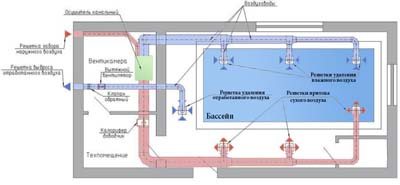

Pools are of sports, health-improving, entertainment and educational purposes. The requirements for them differ, but in general, design work on ventilation systems for an indoor pool should solve the following main tasks:
- Maintaining the required characteristics of temperature and humidity in the area where people are present
- Maintaining the required temperature and humidity characteristics around the cladding and supporting structures of the building
- Ensuring optimal energy consumption of ventilation equipment in all operating modes
At the same time, it is necessary to take into account such factors as the location of the building in the directions of the cardinal points, the height of the floor mark relative to the ground level, the number of people swimming and relaxing in the room, the schedule of visits, heat losses, the power of the heating system, the availability of equipment for dehumidification.
Unlike general-purpose ventilation, which solves the problem of ensuring a high-quality air composition and compensating for internal excess heat by external colder air masses, the pool ventilation system as the main goal is to maintain the proper level of humidity. The rest of the problems (maximum permissible gas concentrations and heat exchange) are solved already in the complex.
Pool ventilation calculation
I will analyze the calculation of ventilation using the example of a pool of 23 m2
| Swimming pool 6.9x3.4m in the cottage | Ventilation capacity of the pool 23 m2 depending on conditions: | ||||
| With counterflow, underwater jets (without dryer) in Moscow | With counterflow, underwater jets (with a dryer) in Moscow | With geyser and fountain (without dehumidifier) in Moscow | With counterflow, underwater jets (without dryer) in Samara | With geyser and fountain (without dehumidifier) in Samara | |
| Inflow | 1540 m3 / h | 770 m3 / h | 1030 m3 / h | 1390 m3 / h | 940 m3 / h |
| Hood | 1710 m3 / h | 860 m3 / h | 1150 m3 / h | 1550 m3 / h | 1040 m3 / h |
| Dehumidifier | – | 117 l / day | – | ||
As you can see, the air volume for the same pool of 23 m2 is different for different conditions, so online calculators cannot take into account all indicators and count with a margin. For example, a counterflow system in a pool increases the size of ventilation equipment by 33%, and installing a water slide by 50%!
For an accurate calculation of your pool, I advise you to develop a ventilation project and do not spare 25-40 thousand rubles. For design, you will need architectural plans in DWG (AutoCAD).
Air supply from the pool floor


Air supply from the pool floor
There is a picture on the Internet where air is supplied to the pool from the floor, and there is a ventilation unit on the technical floor. I have to explain to my Customers that in practice it is impossible to do this:
• It is impossible to punch holes of such a size that the air speed from them would be less than 0.5 m / s, and at a higher speed there will be drafts and discomfort. on which the bowl rests. Quite problematic • In the window area there are heating convectors and piping. You will have to order custom-made convectors, which is long and expensive.
Eventually: in private pools, such a scheme is abandoned in 90% of cases.In commercial swimming pools, this type of air supply is often used, but it is envisaged at the structural stage of the building, where the bowl is a separate monolith.
Basic design standards
The calculated data are in SNiP 2.08.02-89 "Design of pools". There are also building rules SP 31-113-2004 Swimming Pools. Systems responsible for the microclimate inside the swimming pool, namely ventilation, heating, air conditioning, are designed based on the standard indicators:
- Water temperature
- Air temperature and frequency of its exchange for supply and extract
- Relative humidity
The water temperature will vary significantly, depending on the specifics of the pool:
| Bathroom type | Temperature for calculation, 0С |
| Sports | from +24 to +28 |
| For teaching children | from + to +32 |
| For cooling | no more +12 |
| Specialized Jacuzzi Baths | up to +39 |
| Chilled water baths at saunas | up to +15 |
| Diving baths | from +28 to +30 |
In SNiP, it is not recommended to calculate the ventilation system with a temperature higher than + 350C. For pools, this is the limit. Everything above is calculated based on the norms for baths.
Air temperature, frequency of its exchange:
| The name of the working part of the complex | Air temperature for calculation, 0С | Air exchange rate for 1 hour | ||
| Supply | Exhaust | |||
| All rooms where the pool baths are located | It is taken 1-20C higher than the standard water temperature | There are many factors that influence the value. Minimum threshold 80 m3 / h per person in the pool, 20 m3 / h per spectator during the competition | ||
| Training halls | + 18 | An individual calculation is required. Minimum value 80 m3 / h per visitor | ||
| Showers | +25 | 5 | 10 | |
| Massage room | +22 | 4 | 5 | |
| Restroom | +22 | 3 | 3 | |
| Study rooms | +18 | 3 | 2 | |
| Water chlorination rooms | +16 | 10 | 12 | |
The guideline values indicated above are for the calculation of ventilation systems for public and private swimming pools. For the second group, not all values are used, as the classic example of a private pool is a small space from one room.
The designer pays special attention to the mobility of air masses. The quality of mixing and removal of old exhaust air, as well as the absence of drafts, depends on the intensity of their movement. In the main hall, the speed of movement is not more than 0.2 m / s. In other rooms up to 0.3 m / s. If there are stands, then the calculation is performed twice, when they are full of spectators and when the hall is empty. The calculated limit for relative humidity is 65% for the main hall and 60% for the auxiliary rooms.
Temperature balance
Moisture condensation diagram
The primary parameter that has a decisive influence on the calculation of the ventilation system. It affects the saturation humidity. This is the amount of water vapor dissolved in the air.
The water never stops evaporating. The task of the designer is to reduce the intensity of the process. The total power and cost of the ventilation system depends on this.
The saturation humidity will be minimal when the temperature difference between air and water is 1-20C. The air is always warmer than water. If on the contrary, the evaporation and condensation of moisture will accelerate. More powerful ventilation units will be required.
Private pool ventilation schemes
All microclimate maintenance schemes are reduced to a combination of ventilation and a dehumidifier. This is the combined dehumidification method.
There are 3 options:
• supply and exhaust units (separate); • supply and exhaust unit (single) with a bypass channel; • air handling unit (single unit) with a recuperator.
All 3 options are combined with a dehumidifier and we get 3 more schemes:
• supply and exhaust units (separate) with a dryer; • supply and exhaust unit (single) with a bypass channel and a dryer; • air handling unit (single unit) with a recuperator and a dehumidifier.
Let's figure it out, but looking ahead I'll say:
There is only one correct ventilation and dehumidification scheme for a private pool. The very first. Dehumidifiers are expensive and stupid. And recuperation and bypass are only suitable for large commercial pools.
Let's analyze each equipment in order, and everything will become clear.
Ways to reduce humidity in the pool room
Reducing air humidity can be carried out in two ways:
- condensation;
- assimilation.
Moisture condensation in the pool
Moisture condensation diagram
The air is forced through the dehumidifier where its temperature reaches the dew point. The moisture condenses, after which the air is heated to the desired temperature and returned to the room.
Such installations are good for ventilation of a pool in a cottage, where an inflow-blowout system cannot be implemented. The design is equipped with a hygrostat, which starts the compressor when the humidity reaches a certain reading. As soon as the humidity drops, the hygrostat stops the compressor. In this case, the fan can continue to rotate.
Condensing dryers are:
Wall-mounted, which are hung on the walls. They can be installed in a finished premise;
Wall mounted hidden. All the equipment is hidden in the adjoining room, only the intake grill goes into the pool room. It is necessary to plan such a ventilation system for a pool in a private house during the construction phase;
Stationary. These are powerful installations requiring a dedicated room. They can be included in the supply and exhaust ventilation system for the swimming pool of the sports complex. The stationary dehumidifier allows mixing 1/5 of the air volume. Air inflow and outflow are provided by a system of air ducts. Equipping the system with a duct heater, we get full ventilation.
Water assimilation in the pool
Moisture assimilation scheme
Supply and exhaust systems work according to this principle, using the property of air to absorb water vapor. With an approximate calculation, a 5-fold air exchange per hour is laid.
Often in temperate latitudes, only ventilation is enough to maintain the required microclimate in a small private pool. But when calculating the ventilation of swimming pools of sports or entertainment complexes, you cannot do without a dehumidifier. Especially if they are located in hot climates.
The second significant drawback is that the supply air must be heated. This is especially noticeable in the cold season, when a maximum of electricity is consumed for heating.
Combined pool dehumidification method
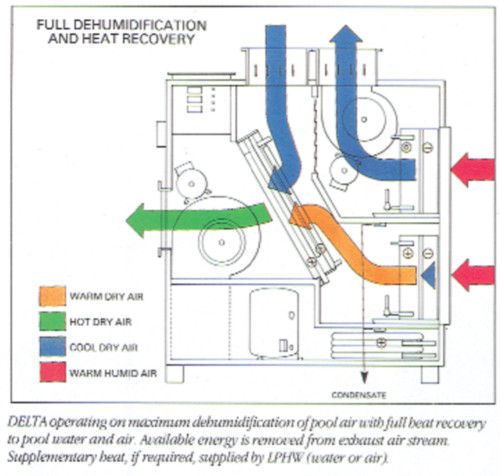

Combined moisture reduction system
The optimal type of dehumidification and ventilation system for intensive swimming pools and large areas. Experts recommend using both a dehumidifier and forced ventilation. Systems can be independent, not connected in any way, or constitute a general microclimate control system.
This is an expensive equipment that justifies itself only in pools with an area of at least 50 sq. meters.
Recuperator for the pool. Why not needed?
A recuperator is a section in an air handling unit that saves 50% of heat for heating the supply air in winter.


It is cold outside in winter, so you need to heat it up to supply air to the pool. It can be heated with water or electricity, but this is always an additional cost. The customer wants to save on operating costs and is doing the right thing, but the recuperator is not needed in the pools and is even harmful.
That's why:
In winter, the air outside is cold, but very dry, so very little is needed to drain the pool - 7 times less than in summer. It remains only to heat up. As a result, the volume of air for draining the pool in winter is very scanty, from 350 to 500 m3 / h, and a minimum of 1500 m3 / h is required for the payback of the recuperator.
The recuperator is needed in pools with a water surface of at least 80 m2.
In winter, the air handling unit will reduce the speed, and the air heater will operate at a minimum. It turns out that there is simply nothing to save. In the summer, the unit will increase the air supply, but the heater will not work.
With the installation of a recuperator in the pool, we get a big problem.
The recuperator in the pool is constantly freezing and condensation flows. Due to the fact that the exhaust air is humid, and the supply air from the street is very cold, the walls of the recuperator are very cooled. The humid extract air condenses on the cold walls of the recuperator i.e. moisture falls out of the air. As a result, in autumn and spring, condensate constantly flows from the installation. And when cold weather sets in, the moisture on the walls of the recuperator freezes and the equipment constantly turns on the defrost mode.
Output: The recuperator in the ventilation of the pool is simply not needed. The supply air volume in winter is too small to save heat, and the extract air is too humid, which will lead to condensation on the walls of the recuperator and subsequent freezing.
If you really want to conserve heat in your ventilation system, consider louvers to cover the water mirror outside of business hours. So you can reduce the moisture release of the pool, and therefore reduce the air volume and consumption of the ventilation system by 70%.
Organization of supply and exhaust ventilation of the pool room


And now, finally, we come to the realization of the need to equip all the same supply and exhaust ventilation of swimming pools. It is also possible to organize supply and exhaust ventilation in different ways - it can be two separate ventilation units (supply and exhaust), for example VEZA VEROSA, each of which performs its own work. However, it would be most expedient to combine both of these installations into one and thereby save on installation space. VEZA's range of products includes specialized installations for ventilation of swimming pools AQUARIS. These installations, along with providing a comfortable microclimate in the pool room, also allow you to significantly save on heating the supply air, due to such built-in equipment as recuperators, heat pumps.
The use of the air handling unit gives the customer the opportunity to get full air exchange in the pool room
It is very important to observe the negative imbalance in the room when setting up the unit. This means that the amount of air removed from the pool room should be slightly larger than the amount of air supplied to the same room.
Existing standards (SP 31-113-2004) tell us that the volume of the extract air should be greater than the supply air by no more than half of the ventilated volume of the room (0.5 krat)
Next, you should also pay attention to the air speed. So, in order to avoid discomfort, drafts and intensification of moisture evaporation, in the area where bathers are staying and above the water surface, the air speed should be at the level of 0.15 ÷ 0.20 m / s
To prevent aerodynamic noise from the air at the outlet from the air distribution grilles, an outflow velocity of the order of 2 ÷ 3 m / s should be observed.
Swimming pool ventilation unit
For swimming pools, we use conventional separate supply and exhaust units. In this case, we have the opportunity to more flexibly approach the placement of equipment. Separate units take up significantly less space than systems with a recuperator. They can be located in different rooms, for example, in the attic, in the basement and even in the suspended ceiling of the pool itself. The air handling unit, operating in 2 modes, delivers 3000 m3 / h in summer, and heats and supplies only 400 m3 / h in winter. The air extraction unit throws humid air outside, and the heating cable on the outdoor grilles protects them from icicles.
This is the simplest and most efficient ventilation scheme.To heat 400 m3 / h of air, you need only 7.5 kW of thermal energy from the boiler (not to be confused with electricity consumption) and this is at -25 ° C outside.


Correct ventilation system in the pool of a private house
Supplier companies will convince you to buy expensive air handling units for swimming pools, which in 90% of cases are not needed at all. As soon as you say “pool”, they have “pool installations” in their heads. And why such an attitude is needed - they cannot explain.
Svegon and Menerga companies offer equipment from 600,000 rubles. 100% of private pools do not need them, and 90% of commercial pools use 2 separate units, one with a dehumidifier and the other without.
In projects for pools in private houses, we use conventional supply and exhaust units from NED, Breezart, Systemair, Ventmachine. We design suspended, channel-type installations in a sound-insulated casing with a full set of automation.
Installation of climatic complexes
In pools with a water surface area of more than 50 m2, modern climatic systems are used for the purpose of air exchange and ventilation. These multifunctional units are designed to maintain the microclimate in specified modes throughout the year.
They are capable of cleaning, dehumidifying and heating the air masses of the room. These modular units are supplied ready-to-install.
The complex consists of the following elements:
- supply and exhaust fans;
- recuperator;
- dehumidifier;
- heater;
- filter;
- air valves;
- Control block.
The complete set is individual and can be changed according to the preferences of customers. Such a complex operates in different modes.
Its sensors react to changes in air parameters and the unit automatically changes the operating mode to a more suitable one. Such climatic complexes are distinguished by impressive dimensions, therefore, a special room must be allocated for their installation.


The climatic complex is a powerful unit with impressive dimensions and advanced functionality.
Such a powerful climate control unit is able to maintain the required microclimate in rooms with a large area.
The use of this climatic complex can replace heating devices, dehumidifiers, air handling units throughout the room. Complexes of this type are often installed in cottages, private houses, medical and sports pools.
Why do you need ventilation in a room with a pool?
The mirror of the water in the pools in a home or public facility is large. This means that huge fumes come from it. And this is not only water, but also various chemicals that are introduced into the liquid in the form of cleaning preparations. That is, the microclimate inside a room with a swimming pool is not the most favorable.
A person quickly gets tired of humidity, discomfort appears, but he comes to the pool to rest. In addition, if you do not control the humidity indicator, then condensation appears on the walls, windows and other structures of the structure, from which later you expect troubles in the form of mold and fungi. And the humid atmosphere negatively affects the quality of building structures.
Therefore, a ventilation system is installed in these structures, with the help of which moist air vapors are removed, and, accordingly, the humidity itself decreases. And here it does not matter whether a ventilation system is arranged in the pool of a private house or it is a public or sports facility. But it should be noted that any ventilation in the pool will not work. Here, only the supply and exhaust is used, or it is with an air dryer.







